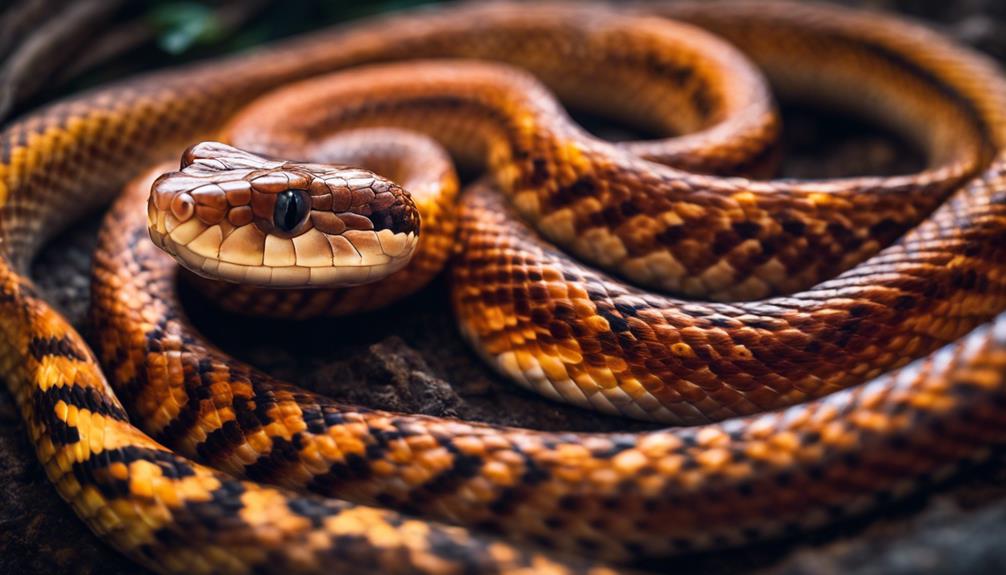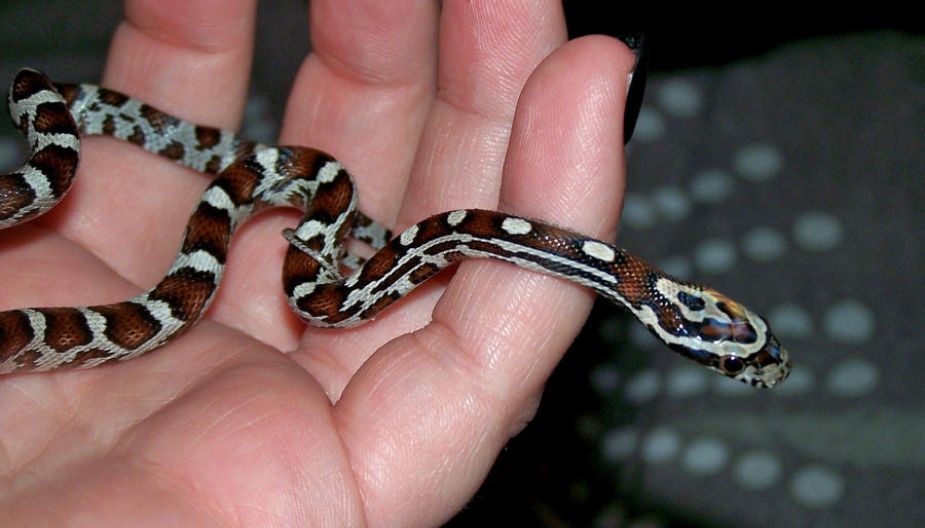Are you curious about the gender of your corn snake? Knowing whether your snake is male or female can be crucial for its appropriate care and breeding plans.
There are reliable strategies to ascertain your corn snake’s sex, including observing physical traits like tail shape and scale count and examining the cloacal opening.
Comprehending these indicators will not only support you in developing a robust connection with your pet but also assist in offering specialized care based on their gender-specific requirements.
To determine if a corn snake is male or female, check the vent near the tail; males have a longer space before the vent and two small protrusions. Females have their vents closer to the tail and lack these protrusions.
Physical Characteristics of Male Corn Snakes
When determining the gender of corn snakes, observing the physical characteristics of male snakes can provide clear indicators. One key feature to examine is the tail. Male corn snakes typically have a thicker tail after the cloacal opening compared to females. This tail isn’t only thicker but also longer than that of female counterparts. Moreover, male corn snakes may exhibit subtle dark streaks down their body, especially in larger individuals.
To further determine the gender of a corn snake, counting scales after the cloacal area can be instrumental. Males generally have 140 or more scales, while females have 130 or less scales in this region. Additionally, examining the external genitalia can be important in identifying the gender of a snake.
These specific physical cues, such as tail shape and size differences, are essential in distinguishing male corn snakes from their female counterparts. By carefully observing these characteristics, you can accurately determine the gender of your corn snake.
Physical Characteristics of Female Corn Snakes
Female corn snakes can be distinguished from their male counterparts by the immediate tapering of their tails after the cloacal opening. This tapering is a notable feature, with the tail becoming thinner compared to male corn snakes. Female corn snakes generally have 130 or fewer subcaudal scales after the cloacal region, contributing to their slender tail appearance. Unlike males, females exhibit a consistent body width along the length of their tail, maintaining a streamlined look. Additionally, female corn snakes may have smaller and less prominent spurs near their cloaca, which further aids in their identification.
These physical characteristics collectively provide a reliable method for differentiating female corn snakes from males based on their tail taper, subcaudal scales, body width, spurs, and cloaca features. By observing these traits closely, you can accurately determine the gender of your corn snake.
Behavioral Differences Between Male and Female Corn Snakes
To differentiate between male and female corn snakes based on their behavioral tendencies, observe distinct patterns such as territorial marking in males and nesting behaviors in females. When evaluating the behavior of your corn snake, consider the following key differences:
- Scent Marking and Territorial Behavior: Male corn snakes are more likely to exhibit scent-marking behaviors, rubbing against objects to establish their territory within the enclosure. This behavior is often linked to their need to attract females during breeding seasons.
- Nesting Behaviors: Female corn snakes may display nesting behaviors by burrowing in the substrate or creating cozy spots in their habitat. This behavior is commonly associated with their maternal instincts, preparing a suitable environment for potential eggs.
- Increased Activity Levels: Males tend to show increased activity levels, especially when seeking out potential mates during the breeding season. This heightened activity can be a notable behavioral clue when differentiating between male and female corn snakes.
Methods for Determining the Gender of Your Corn Snake
Observing the physical characteristics of a corn snake can provide valuable insights into determining its gender accurately. Male corn snakes typically exhibit a thicker tail after the cloacal opening, while females have a tail that tapers immediately after the cloacal region.
Another method involves counting the number of scales after the cloacal opening, with 130 or fewer scales usually indicating a female and 140 or more indicating a male. Behavioral cues such as tail length and subtle dark streaks can also aid in differentiating between male and female corn snakes.
However, the most reliable method for determining the gender of a corn snake is by probing the cloacal opening. This technique is best performed by a herpetologist to verify accuracy.
Tips for Accurately Sexing Your Corn Snake
When sexing your corn snake accurately, it’s essential to utilize a combination of physical characteristics and behavioral cues for a reliable determination. Here are three tips to help you accurately sex your corn snake:
- Tail Shape: Male corn snakes typically have a thicker tail after the cloacal opening, while female corn snakes have a tail that tapers immediately after the cloacal. Observing this difference in tail shape can provide valuable insight into the snake’s gender.
- Simply Count: Counting scales after the cloacal opening can also help differentiate between male and female corn snakes. A count of 130 or fewer scales usually indicates a female, whereas 140 or more scales are often seen in males. This simple counting method can aid in determining the snake’s sex.
- Consult a Reptile Vet: If you’re unsure about sexing your corn snake or need confirmation, consulting a reptile vet is a reliable option. A professional can use probing techniques or other non-invasive methods to accurately determine the gender of your corn snake.
Frequently Asked Questions
How Do I Tell if My Corn Snake Is a Boy or a Girl?
To determine if your corn snake is a boy or a girl, observe tail length differences, ventral scale counts, behavioral cues, and subtle hemipenal bulges. For precise identification, consider cloacal probing or popping hemipenes with expertise.
How Do I Tell the Gender of My Snake?
To determine the gender of your snake, consider using the popping method, probing technique, or examining hemipenes. Observing tail length, cloacal openings, scent gland size, and behavior differences can also help in identifying your snake’s gender accurately.
What Determines a Snake’s Gender?
To determine a snake’s gender, consider hormone levels, genetic markers, physical characteristics, reproductive organs, behavioral differences, skin coloration, and size variances. These factors interact in intricate ways to define the sex of a snake.
Do Female Corn Snakes Have Longer Tails?
Female corn snakes generally do not have longer tails compared to males. Tail tapering and the number of subcaudal scales are better indicators of gender. Observing these physical traits can help determine if your corn snake is male or female.
Conclusion
After carefully observing the physical characteristics and behaviors of your corn snake, you can confidently determine its gender. Remember, a thicker tail and more scales after the cloacal opening typically indicate a male, while a tapered tail and fewer scales suggest a female.
Just like counting the rings on a tree to reveal its age, examining these features will reveal the hidden secrets of your snake’s identity. Trust the signs nature has provided and reveal the mystery of your corn snake’s gender.


